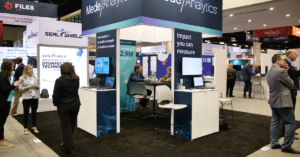Here at MedeAnalytics, we’re all a little nerdy. We get excited about what’s on the horizon for technology and spend our days thinking up new ways to meaningfully apply emerging innovations to healthcare. In our new Impact Innovation Fireside Chat series, healthcare tech aficionado Andy Dé brings the hype and ideas straight to you through live conversations with some of the brightest minds in the industry.
In the first Fireside Chat, Andy sat down with Chief Analytics Officer at MedeAnalytics, David Schweppe, to talk all things AI. In this blog post, we share high points and key takeaways from the conversation. If you’re ready to get inspired, read on!
Building blocks of AI
Artificial intelligence encompasses and enables various established and emerging technologies, including machine learning, natural language processing, deep learning, computer vision, and medical robotics. One of the most fascinating applications of our time is generative AI; we’ve seen Chat GPT, Bing Search, and similar platforms taking the world by storm. Debates will continue regarding its effectiveness and the technology itself will continue to evolve, but of one thing our experts are sure: generative AI is not going anywhere.
Credibility of generative AI
Generative AI can work incredibly well when it has curated, credible data to work with, but it can also be a garbage-in, garbage-out scenario when reliable sources are not available or utilized. This leads to what is being actively and appropriately called hallucinations, where generative AI starts returning answers that are misleading and inaccurate. When applying generative AI, Andy and David advise users to understand its immense potential as well as its potential shortcomings.
AI is not the hammer for all nails
Generative AI is a fantastic tool, but it is not the tool to end all other tools nor is it a panacea of everything you can have. It doesn’t answer all questions. But what it has done, notes David, is bring AI and machine learning capabilities into the social fiber of our culture. It is now part of common language, and that familiarity in and of itself raises a plethora of opportunities to help explore what we could do with this technology.
Intersection of AI and healthcare
There are many practical applications for AI in healthcare contexts. One that struck a chord with Andy is clinicians using generative capabilities to adapt their bedside communication tendencies to be clearer and convey more empathy. Other powerful use cases include:
- Machine learning to support population risk stratification and care gap identification
- Advanced analytics to match community needs with appropriate resources, impactful interventions and latest best practices
- Generative AI to summarize patient charts and recommend relevant literature related to patient conditions
- Natural language processing with translation capabilities to facilitate better patient-provider communication and improve health outcomes
The ethics of it all
When applying AI to real-world situations, users must be conscious of the ethical considerations around this type of technology. To begin, David said, use common sense. If something seems surprising, unexpected or confusing, do more digging. Using generative AI is a great place to begin, but it is not a replacement for human evaluation and elucidation.
The other major ethical concept we must consider is bias. Systems and algorithms—just like people—can be culturally, politically, or economically biased. Especially in medical contexts, bias can be highly dangerous. Learn as much as you can about the tools you are using, how they work and what they are built to do. It is part of our role as responsible users to make wise, ethical decisions.
Potential future scenarios
To close out, Andy and David flexed their clairvoyance muscles and tossed around some ideas for what the future of AI innovation might look like in healthcare:
- Advancements in precision medicine and remote monitoring
- Incredible, AI-enabled prosthetics
- Improvements in predictive and prescriptive care
One thing the experts don’t anticipate is AI having empathy or having reasoning power. It isn’t replacing clinician training, wisdom and judgement. It is simply offering potential conveniences and efficiencies that can help clinicians practice at top-of-license—and ensure the best outcomes for patients.
Stay tuned into our LinkedIn channel to hear about future Impact Innovation Fireside Chats. Join us to embrace your inner technology nerd – all are welcome!
Get our take on industry trends
Optimizing opportunity in value-based care
Our own Dave Schweppe (Chief Analytics Officer) and David Wolf (AVP, Payer Solutions) sat down with Todd Sauers, Manager of…
Read on...Expert Q&A: The HEDIS details all health plans need to know
With HEDIS certification season quickly approaching, we sat down with MedeAnalytics experts Melissa Linder, Director of Product Management, and Lori…
Read on...Looking back at HIMSS22
Our MedeAnalytics team was thrilled to be back in person for this year’s HIMSS event, after a two-year hiatus due…
Read on...A look ahead at payer analytics innovation
Pioneering payers know that building a strong foundation is the key to enacting sustainable innovation. This foundation typically includes the…
Read on...


